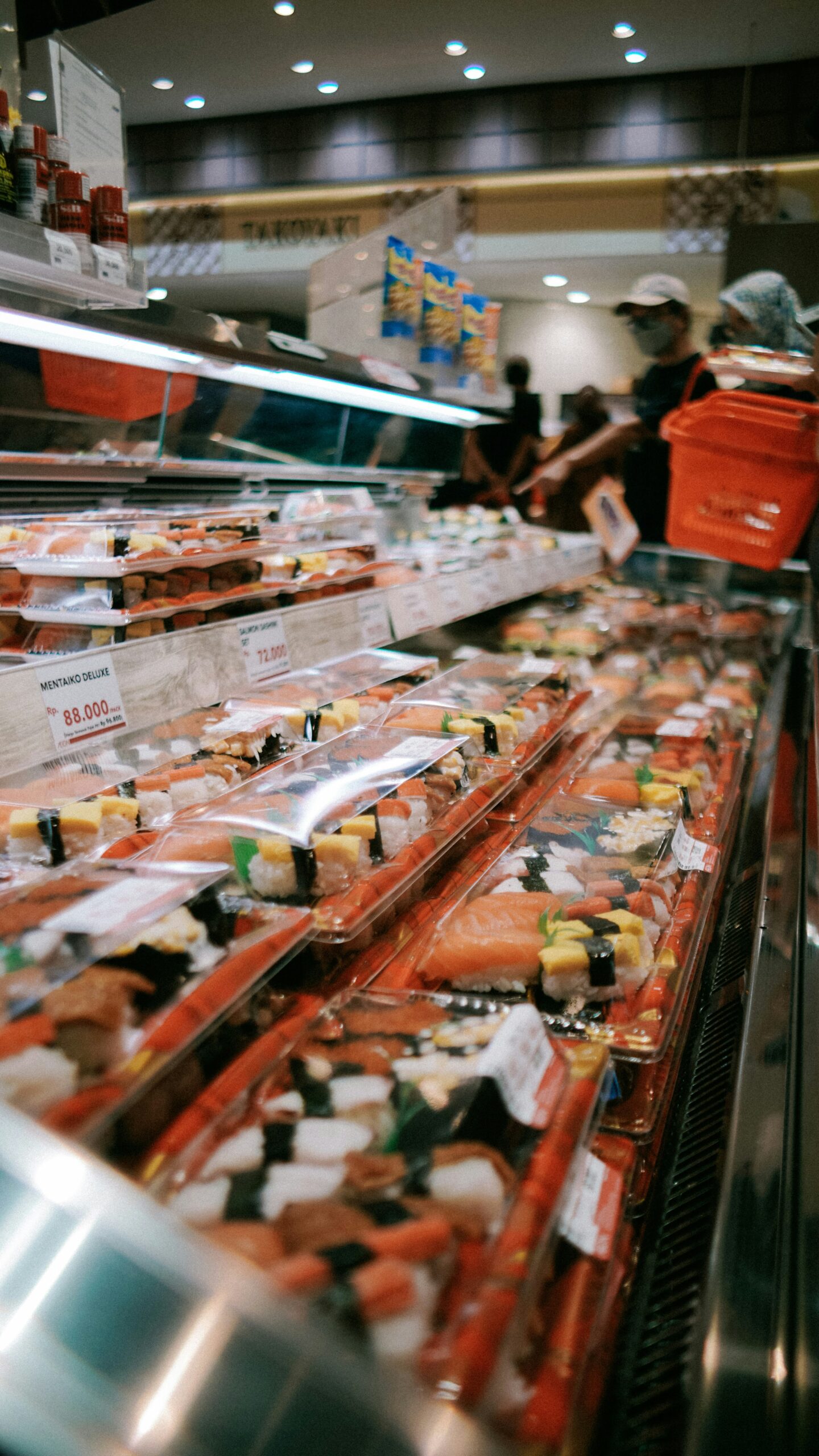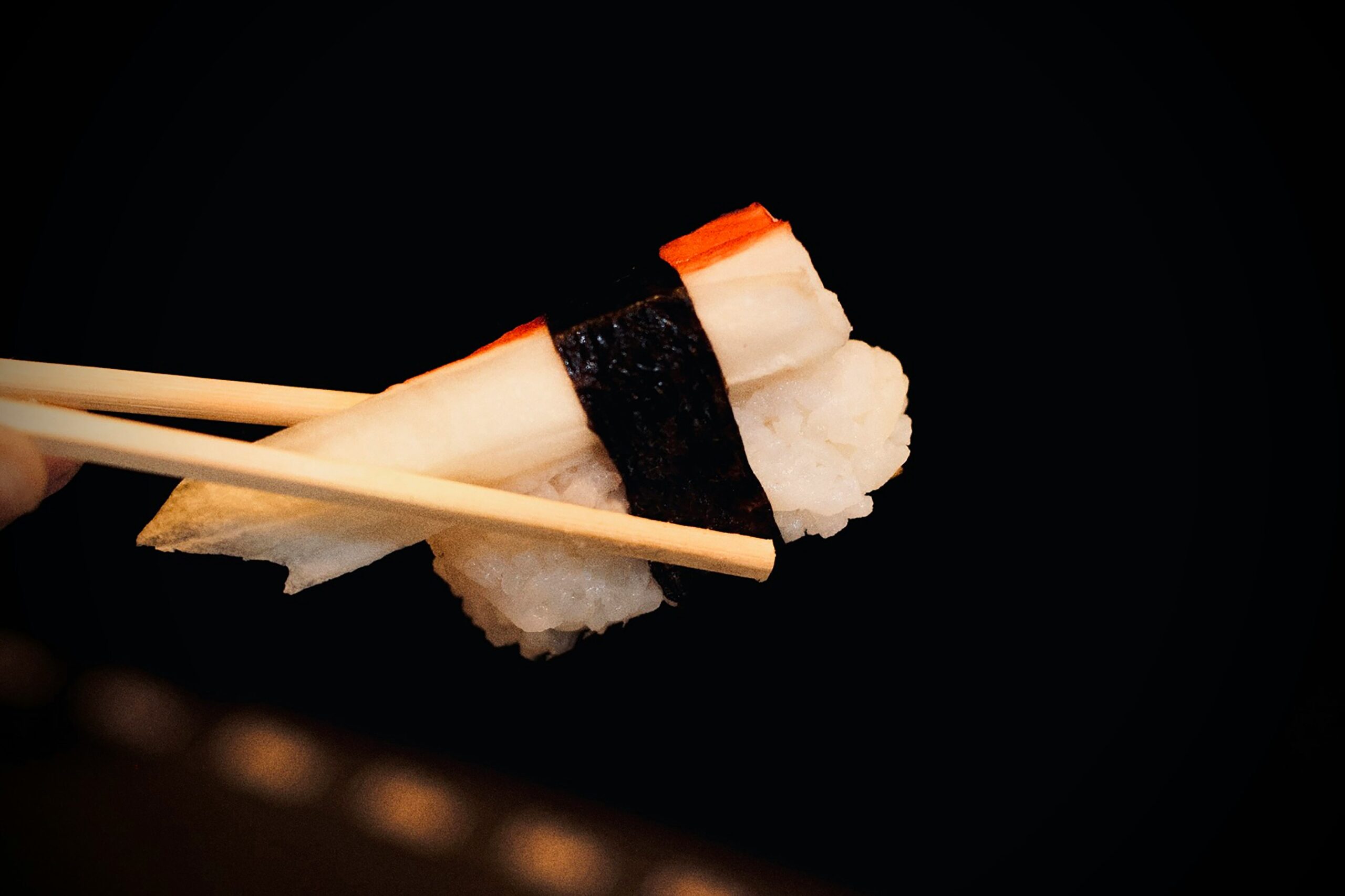Tag: food
-

From Shortage to Sushi: How the 2020 Meat Crisis Shifted America’s Palate
In the spring of 2020, the COVID-19 pandemic disrupted global supply chains, leading to significant shortages in various sectors, notably the meat industry. As beef and pork supplies dwindled due to processing plant closures and operational challenges, consumers sought alternative protein sources, with seafood—particularly sushi—emerging as a popular choice.
Meat Industry Disruptions
The pandemic’s onset saw numerous meatpacking plants across the United States becoming hotspots for COVID-19 outbreaks. By April 27, 2020, at least 4,913 workers in 115 meat and poultry processing facilities across 19 states had contracted the virus, with 20 reported fatalities. This led to sporadic shutdowns and a reduction in meat processing capacity. Specifically, pork processing experienced a 25% reduction, and weekly beef production saw a 19% year-over-year decline by late March 2020.
These disruptions resulted in spot shortages of meat products nationwide. Fast-food chains like Wendy’s faced beef shortages, leading to menu adjustments, while retailers such as Costco and Kroger implemented purchase limits on meat items. Concurrently, millions of farm animals, including chickens and pigs, were euthanized due to processing bottlenecks, further exacerbating supply issues.
Shift to Seafood and Sushi:
With traditional meat sources becoming scarce, consumers pivoted to alternative proteins. Seafood, especially sushi, gained prominence during this period. Several factors contributed to this shift:
1. Availability: Seafood supply chains remained relatively stable compared to the meat industry. Fisheries and seafood processors adapted quickly to changing demand patterns, ensuring a consistent supply to retailers and consumers.
2. Health Perceptions: Sushi, often perceived as a healthier option, appealed to health-conscious consumers seeking nutritious meals during the pandemic. The emphasis on fresh ingredients and omega-3-rich fish made sushi an attractive alternative.
3. Convenience: Grocery stores expanded their ready-to-eat sushi offerings, making it accessible for consumers seeking quick meal solutions without the need for preparation.
Grocery Store Sushi Surge
Grocery retailers observed a notable uptick in sushi sales during the meat shortages. Chains enhanced their sushi sections, offering a variety of options to cater to diverse palates. The convenience of purchasing prepackaged sushi combined with its perceived health benefits made it a go-to choice for many households.
Long-Term Implications:
The pandemic-induced meat shortages and the subsequent shift to seafood alternatives like sushi have had lasting effects on consumer behavior:
• Diversified Diets: Consumers became more open to incorporating a variety of protein sources into their diets, reducing reliance on traditional meats.
• Sustainable Choices: The crisis prompted discussions about sustainable food sources. Seafood, when sourced responsibly, offers a more sustainable protein alternative, aligning with the growing consumer emphasis on environmental considerations.
• Prepared Food Consumption: The success of grocery store sushi highlighted a trend toward convenient, ready-to-eat meals. This shift has encouraged retailers to expand their offerings in the prepared food sector, catering to the evolving preferences of consumers.
In conclusion, the meat shortages of spring 2020 acted as a catalyst for change in consumer protein preferences. Seafood, particularly sushi, emerged as a viable and attractive alternative, leading to a diversification of diets and influencing long-term food consumption trends. -

Overcoming Hesitancy: Embracing Grocery Store Sushi
Sushi, a culinary art form originating from Japan, has become a global favorite. Traditionally enjoyed in specialized restaurants, sushi is now widely available, including in grocery stores. However, many consumers remain hesitant to try grocery store sushi due to concerns about freshness and safety. It’s time to dispel these doubts and explore why grocery store sushi can be a delightful and safe option.
The Evolution of Grocery Store Sushi
Grocery stores have recognized the growing demand for convenient, high-quality sushi. In response, many have partnered with reputable sushi providers to offer freshly prepared options. For instance, chains like Kroger and Publix pride themselves on sushi made fresh daily, striking a balance between flavor and texture.
Rigorous Health Protocols Ensure Safety
One of the primary concerns about sushi is the risk associated with consuming raw fish, such as exposure to parasites and bacteria. To mitigate these risks, the U.S. Food and Drug Administration (FDA) mandates that fish intended for raw consumption be frozen to specific temperatures to eliminate parasites. Grocery Stores adhere to these guidelines, ensuring that their sushi offerings are safe for consumption.
Moreover, reputable grocery stores implement strict Hazard Analysis Critical Control Point (HACCP) plans. These plans are systematic approaches to food safety that identify, evaluate, and control potential hazards. By following HACCP protocols, grocery stores maintain high standards in sushi preparation, from sourcing ingredients to the final product.
Fresh Ingredients Enhance Quality
The quality of sushi depends heavily on the freshness of its ingredients. Many grocery stores source high-quality fish and produce to ensure their sushi meets customer expectations. For example, chains like Whole Foods Market emphasize natural and minimally processed foods, aligning with the principles of quality sushi.
In addition to sourcing fresh fish, grocery stores often employ skilled sushi chefs who prepare sushi on-site. This practice not only guarantees freshness but also allows customers to observe the preparation process, adding transparency and trust.
Convenience Without Compromise
Grocery store sushi offers unparalleled convenience. Whether you’re grabbing lunch on the go or planning a quick dinner, prepackaged sushi provides a tasty and convenient option. Stores like Wegmans have received positive feedback for their sushi offerings, with customers praising the freshness and quality.
Tips for Selecting Grocery Store Sushi:
To ensure the best experience with grocery store sushi, consider the following tips:
1. Check Preparation Dates: Opt for sushi that has been prepared the same day. Many stores label their sushi with preparation times, allowing you to choose the freshest options.
2. Observe Storage Conditions: Sushi should be stored in refrigerated sections to maintain freshness and prevent bacterial growth. Ensure that the display case is adequately chilled.
3. Assess Appearance: Fresh sushi rice should be moist but not soggy, and the fish should have a vibrant color without any off-putting odors.
4. Consider Trusted Retailers: Purchasing sushi from reputable grocery chains known for their quality standards can provide additional assurance.
Conclusion
Grocery store sushi has evolved significantly, offering consumers a convenient and safe way to enjoy this beloved cuisine. With stringent health protocols, fresh ingredients, and skilled preparation, there’s little reason to hesitate. So, the next time you’re at your local grocery store, venture to the sushi section and give it a try—you might be pleasantly surprised by the quality and flavor that await you.
-

Rolling with Change: The Surge of Grocery Store Sushi Amidst the COVID-19 Pandemic
As the COVID-19 pandemic continues to reshape our daily lives, one unexpected culinary trend has emerged: the rising popularity of grocery store sushi. With traditional dining options limited due to health concerns and restrictions, consumers are increasingly turning to supermarkets to satisfy their sushi cravings. This shift is influenced by changing consumer behaviors, innovative adaptations by grocery stores, and a redefined perception of sushi as an accessible meal option.
Evolving Consumer Preferences
The pandemic has significantly altered dining habits worldwide. With many restaurants operating under restrictions or closing entirely, consumers have sought convenient and safe alternatives to enjoy their favorite foods. Grocery stores have stepped in to fill this void, offering a variety of ready-to-eat meals, with sushi becoming a standout choice. The availability of fresh, affordable, and conveniently packaged sushi has made it an attractive option for those looking to enjoy restaurant-quality meals at home.
Grocery Stores Innovate and Adapt
Recognizing the growing demand, grocery chains have adapted by expanding their sushi offerings and ensuring quality. For instance, Kroger has become America’s top sushi seller, offering a wide variety of sushi options to cater to diverse tastes. Similarly, regional chains like Gelson’s have reported significant increases in sushi sales, prompting them to introduce new and innovative sushi products. This adaptability has not only met consumer demand but has also positioned grocery stores as viable competitors to traditional sushi restaurants.
Technological Advancements in Sushi Preparation
To meet the rising demand efficiently, some establishments have incorporated technology into their sushi preparation processes. Automation, such as rice-cooking robots, ensures consistency and speed, allowing stores to keep up with consumer needs while maintaining quality. This blend of technology and culinary arts has enabled grocery stores to offer fresh sushi at a scale previously thought unattainable.
Sustainability and Responsible Sourcing
Consumers are increasingly conscious of sustainability, influencing their purchasing decisions. Grocery stores have responded by emphasizing responsibly sourced sushi ingredients. For example, Albertsons rolled out responsibly sourced sushi across its banners, meeting its Responsible Seafood Policy goals ahead of schedule. Such commitments resonate with consumers, further boosting the appeal of grocery store sushi.
The Future of Grocery Store Sushi
The pandemic has accelerated changes in consumer behavior, with grocery store sushi emerging as a popular choice for many. By adapting to new demands, embracing technology, and focusing on sustainability, supermarkets have successfully positioned sushi as a convenient and desirable meal option during these challenging times. As we navigate the ongoing pandemic, it is likely that grocery store sushi will continue to grow in popularity, reflecting a broader trend toward convenient, high-quality, and responsibly sourced meal options.
In conclusion, the COVID-19 pandemic has reshaped the culinary landscape, with grocery store sushi exemplifying how adaptability and innovation can meet evolving consumer needs. As supermarkets continue to refine their offerings, consumers can enjoy the convenience and quality of sushi from the comfort of their homes, a trend that may well outlast the pandemic itself.
-

Sushi Surge: Why Sushi Chefs Can Anticipate Rising Sales in the Coming Years
The global sushi industry is experiencing a remarkable upswing, offering sushi chefs ample reasons to be optimistic about future sales. This growth is driven by an expanding consumer base, record-breaking sales figures, and the burgeoning popularity of grocery store sushi offerings.
Expanding Sushi Audience and Record Sales
Sushi, once considered a niche delicacy, has firmly established itself in mainstream dining across the globe. In the United States, the sushi restaurant sector’s market size reached $27.9 billion in 2022, reflecting significant growth. Projections indicate that this upward trajectory will continue, with the market expected to grow by $3.92 billion between 2025 and 2029.
Several factors contribute to this surge in popularity. The rise of health-conscious consumers seeking nutritious and low-calorie meal options has positioned sushi as an attractive choice. Additionally, the globalization of cuisine has introduced diverse populations to Japanese culinary traditions, further broadening sushi’s appeal. Innovations such as plant-based sushi and fusion recipes have also played a role in attracting a wider audience.
The Rise of Grocery Store Sushi
A notable trend contributing to the industry’s growth is the increasing availability of sushi in grocery stores. Retailers have recognized the demand for convenient, high-quality sushi options, leading to a significant expansion of in-store sushi offerings. For instance, Kroger has become the largest seller of sushi in the U.S., selling more than 40 million pieces annually. Overall, supermarket sushi sales have surged, with some retailers experiencing over 70% growth in the past year.
This shift towards grocery store sushi aligns with consumers’ desires for quick, affordable, and healthy meal options. The convenience of purchasing sushi alongside regular grocery shopping has made it an increasingly popular choice, especially among millennials and urban dwellers. Retailers have responded by enhancing the quality and variety of their sushi offerings, often partnering with skilled sushi chefs to ensure authenticity and freshness.
Implications for Sushi Chefs
The growing popularity of sushi presents numerous opportunities for sushi chefs:
1. Increased Employment Opportunities: The expansion of sushi offerings in both restaurants and grocery stores has led to a higher demand for skilled sushi chefs. This trend is expected to continue as more establishments seek to capitalize on sushi’s popularity.
2. Diverse Work Environments: Sushi chefs now have the option to work in various settings, from traditional sushi restaurants to supermarket sushi counters, catering services, and even food trucks. This diversity allows chefs to choose environments that best suit their skills and career aspirations.
3. Creative Culinary Innovations: With the fusion of different cuisines and the introduction of plant-based sushi options, chefs have the opportunity to experiment and innovate, creating unique offerings that cater to evolving consumer tastes.
4. Educational Roles: As interest in sushi grows, so does the demand for sushi-making classes and workshops. Experienced chefs can leverage this trend by offering instructional sessions, thus sharing their expertise and fostering a deeper appreciation for the art of sushi.
Conclusion
The sushi industry’s robust growth trajectory offers a promising outlook for sushi chefs. The expanding consumer base, record sales figures, and the integration of sushi into grocery retail underscore the cuisine’s mainstream acceptance and enduring appeal. For sushi chefs, this translates into abundant opportunities for career advancement, creative expression, and participation in a dynamic and evolving culinary landscape.
-

Sushi’s American Evolution: A Decade of Rising Popularity
Over the past decade, sushi has experienced remarkable growth in popularity across the United States, evolving from a niche delicacy to a mainstream culinary staple. This surge is evident in the significant expansion of sushi restaurants nationwide, reflecting a broader acceptance and appreciation of Japanese cuisine.
Expansion of Sushi Restaurants
The proliferation of sushi establishments is a clear indicator of its rising popularity. In 2011, the United States was home to approximately 11,939 sushi restaurants. By 2021, this number had surged to 18,944, marking a 57% increase over the decade. Notably, 2017 alone saw a 12% rise, with 1,868 new sushi establishments opening that year. This growth underscores the increasing demand and integration of sushi into the American dining scene.
Market Growth and Economic Impact
The economic footprint of the sushi restaurant sector has expanded in tandem with its physical growth. In 2022, the market size of the U.S. sushi restaurant industry reached $27.9 billion, up from $22.59 billion in 2021. This substantial increase highlights sushi’s transition from a specialty cuisine to a significant player in the broader food service industry.
Diversification and Accessibility
Sushi’s evolution in the U.S. is also characterized by its diversification and increased accessibility. Once confined to high-end restaurants, sushi is now available in various formats, from casual eateries and grocery stores to upscale dining establishments. Innovations such as sushi burritos and sushi tacos have emerged, blending traditional elements with American culinary preferences. Additionally, plant-based sushi options have gained traction, catering to the growing number of health-conscious and vegetarian consumers.
Cultural Integration and Consumer Acceptance
The integration of sushi into American culture is a testament to its widespread acceptance. Major urban centers like Los Angeles and New York City have become hotspots for sushi lovers. For instance, Los Angeles’s Ventura Boulevard, dubbed “Sushi Row,” boasts one of the highest concentrations of sushi restaurants outside Japan, illustrating the deep-rooted presence of sushi in the city’s culinary landscape.
Future Outlook
Looking ahead, the sushi industry shows no signs of slowing down. Emerging trends such as the rise of Omakase-style dining, where patrons entrust the chef to select their dishes, are gaining popularity, offering diners personalized and immersive experiences. Moreover, the emphasis on sustainability and sourcing practices is becoming increasingly important, with consumers showing a preference for restaurants that prioritize eco-friendly operations.
In conclusion, the past decade has witnessed a significant transformation in the U.S. sushi landscape. The substantial growth in the number of sushi establishments, coupled with their economic impact and cultural integration, underscores sushi’s transition from an exotic delicacy to a beloved component of American cuisine. As the industry continues to innovate and adapt to consumer preferences, sushi’s popularity is poised to endure and flourish in the years to come. -

The Evolution of Sushi: Contrasting Traditional Japanese Sushi with Its American Counterpart
Sushi, a culinary art form originating in Japan, has undergone significant transformations as it traversed continents. While traditional Japanese sushi emphasizes simplicity and purity, its American adaptations often showcase innovation and fusion. This article delves into the stark differences between these two interpretations, exploring their origins, ingredients, preparation methods, and cultural significance.
Origins and Philosophy
Traditional Japanese sushi, known as “Edo-mae” sushi, traces its roots back to the Edo period (1603-1868). Originally, it was a method of preserving fish by fermenting it with rice and salt. Over time, this evolved into vinegared rice paired with fresh fish. The essence of traditional sushi lies in its simplicity, focusing on the natural flavors of its ingredients without excessive embellishments.
In contrast, American-style sushi emerged as Japanese cuisine gained popularity in the United States during the mid-20th century. Chefs began adapting traditional recipes to suit local palates, leading to innovative creations that often incorporated non-traditional ingredients. This fusion approach reflects a broader trend of culinary adaptation and globalization.
Ingredients and Flavor Profiles
A defining characteristic of traditional Japanese sushi is its minimalism. The primary components include vinegared rice (shari), fresh fish or seafood (neta), and occasionally nori (seaweed). Common varieties are nigiri (a slice of fish atop rice), sashimi (slices of raw fish without rice), and maki (rolled sushi with seaweed, rice, and filling) . The emphasis is on the quality and freshness of the fish, with subtle seasoning to enhance natural flavors.
American sushi, however, often features a diverse array of ingredients. Rolls like the California roll, which includes avocado and imitation crab, cater to local tastes and preferences. Additionally, the incorporation of cream cheese, spicy mayonnaise, and deep-fried elements has become commonplace. These additions result in richer, more robust flavors that differ significantly from the subtlety of traditional sushi.
Preparation Techniques
In Japan, sushi chefs undergo rigorous training, often dedicating years to master the art. The process involves meticulous attention to detail, from selecting the freshest fish to perfecting the texture and seasoning of the rice. Traditional sushi is typically prepared with the nori on the outside, tightly wrapping the rice and filling.
Conversely, American sushi has introduced variations such as uramaki, or inside-out rolls, where the rice is on the outside and the nori inside. This adaptation was initially made to cater to Western aesthetics, as diners were less accustomed to the texture of seaweed on the exterior. Furthermore, American sushi chefs often experiment with presentation, incorporating vibrant colors and elaborate garnishes to appeal to the visual senses.
Cultural Significance and Dining Etiquette
Sushi in Japan is not merely a meal but a cultural experience. Dining etiquette is deeply rooted in tradition; for instance, wasabi is typically applied by the chef between the rice and fish, and additional soy sauce is used sparingly to avoid overpowering the delicate flavors. Sushi is often eaten with the fingers, and appreciating the chef’s craftsmanship is an integral part of the experience.
In the United States, sushi dining is more relaxed and varies widely. Diners commonly use chopsticks and may mix wasabi into their soy sauce, a practice less common in Japan. The atmosphere in American sushi restaurants range from casual to upscale, reflecting the cuisine’s fusion into mainstream culture.
Conclusion
The journey of sushi, from its traditional Japanese roots to its American adaptations, exemplifies the dynamic nature of culinary evolution. While traditional sushi emphasizes simplicity, purity, and a deep respect for ingredients, American-style sushi showcases creativity, fusion, and a willingness to experiment. Both interpretations offer unique experiences, catering to diverse palates and preferences. Understanding these differences enriches our appreciation of sushi as a global culinary phenomenon.